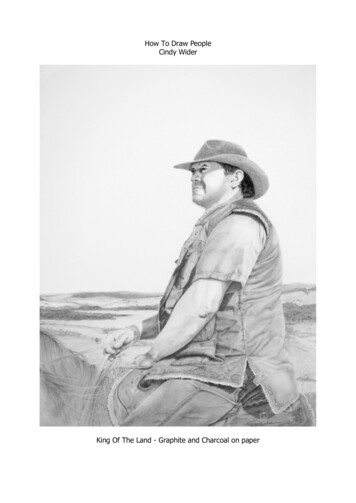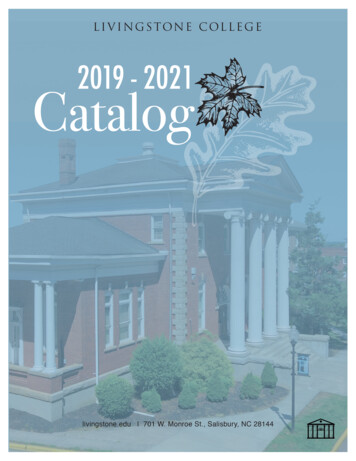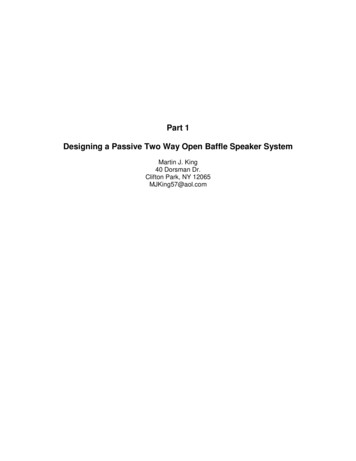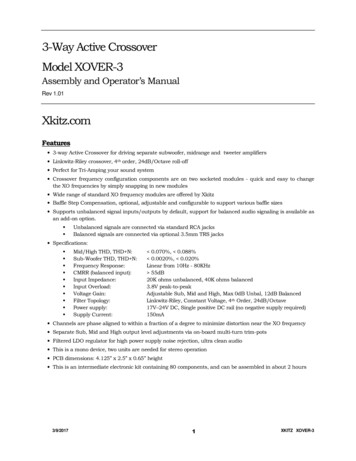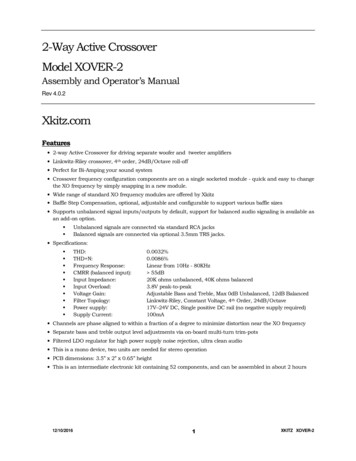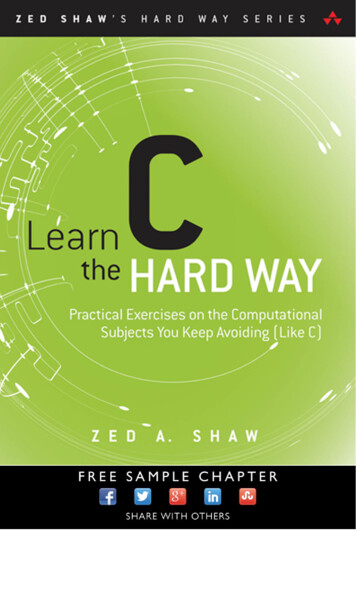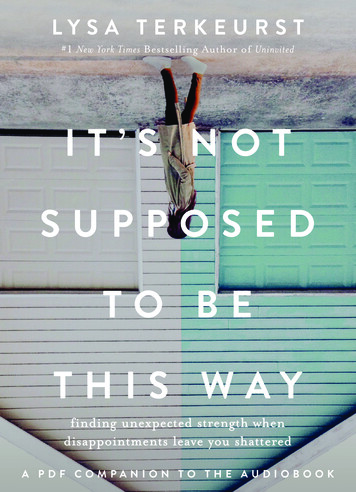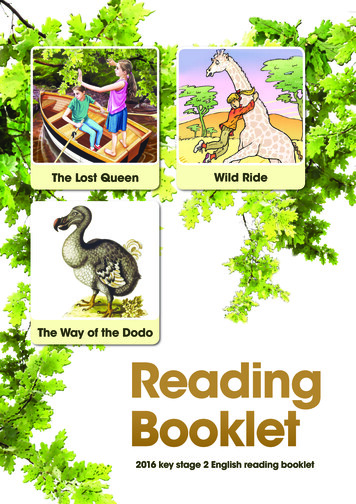
Transcription
The Lost QueenWild RideThe Way of the DodoReadingBooklet2016 key stage 2 English reading booklet
2
ContentsThe Lost Queenpages 4–5Wild Ridepages 6–8The Way of the Dodopages 10–113
Maria and Oliver are attending a party in the gardenof a house that used to belong to Maria’s family. Theysneak away to explore the grounds.The Lost QueenMaria and Oliver were quite a distance from the partywhen they found the little rowing boat in the grassyshallows of a small lake beyond the garden.Glancing nervously behind her, Maria suggested thatthey row out to the island in the middle of the lake.Oliver looked at her questioningly. Maria explained thatthere was a secret monument on the island to one of herancestors. This was a woman who had married a princeat the time when there was a struggle for the throne. Thestruggle had been between two rival families – one had alion as its symbol, the winner had a bear.“Come on,” Maria said impatiently.4
Oliver rowed while Maria stood barefoot in the boat,staring straight ahead. The oars made a click-clack soundin the hush and haze of the summer afternoon. Ripples ofwater fanned out behind them as they crossed the glassysurface of the lake.The tiny island, thick with creeping vines and roots,looked as if it floated. At its centre, an ancient oak treetowered over it. The tree’s branches were like bent fingers,twisting and stretching outwards, until the tips of itsleaves touched the still water. Oliver carefully steered theboat through a narrow opening in the branches. Thenthey stepped out of the boat, and into a murky green spaceunder an umbrella of leaves. The air was cool and damp.Maria led Oliver across the tangled ground to thehidden monument. It was a column of marble, weatheredand mossy with age. A delicate crown sat at the top, andan inscription was carved into a flat slab at the base.Oliver used his thumbnail to scrape out the letters thatwere cut into it.It was a name.Maria’s family name.“You could have been a queen?” said Oliver, whispering.Maria laughed gently in the gloom.“We were the family of the lion,” she said.Oliver could still hear the shouts and laughter of theparty, up on the sunny lawn near the big house. But nowthe noise seemed to be getting further and further away.5
This story takes place in a huge grassland area in southern Africa. The grasslandsthere are called ‘savannah’.Wild RideDawn was casting spun-gold threads across a rosy sky over Sawubona GameReserve as Martine Allen took a last look around to ensure there weren’t anywitnesses. She leaned forward like a jockey on the track, wound her fingersthrough a silver mane, and cried, ‘Go, Jemmy, go.’The white giraffe sprang forward so suddenly that she was almost unseated,but she recovered and, wrapping her arms around his neck, quickly adjustedto the familiar rhythm of Jemmy’s rocking-horse stride. They swept past thedam and a herd of bubble-blowing hippos, past a flock of startled egretslifting from the trees like white glitter, and out onto the open savannah plain.An early morning African chorus of doves, crickets and go-away birds provideda soundtrack.6
For a long time Martine had only ever ridden Jemmy at night and in secret,but when her grandmother had found out about their nocturnal adventuresshe’d promptly banned them, on the grounds that the game reserve’sdeadliest animals were all in search of dinner after dark and there wasnothing they’d like more than to feast on a giraffe-riding eleven-year-old. Fora while Martine had defied her, but after several close calls and one terriblerow with her grandmother, she had come to accept that the old lady was right.When lions were on the hunt, the game reserve was best avoided.Another of her grandmother’s rules was that Martine ride sedately at alltimes. ‘No faster than a trot and, in fact, I’d rather you stuck to a walk,’ she’dcounselled sternly.Martine had paid almost no attention. The way she saw it, Jemmy was a wildanimal and it was only fair that he should have the freedom to do what camenaturally, and if that meant tearing across the savannah at a giraffe’s topspeed of thirty-five kilometres per hour, well, there wasn’t a lot she could doabout it. It wasn’t as if she had reins to stop him. Besides, what was the pointof riding a giraffe if the most he was permitted to do was plod along like somearthritic pony from the local stables?Jemmy clearly agreed. They flew across the grassy plain with the springbreeze singing in Martine’s ears. ‘Faster, Jemmy!’ she yelled. ‘Run for yourlife.’ And she laughed out loud at the heart-pounding thrill of it, of racing awild giraffe.Continued on the next page7
A streak of grey cut across her vision,accompanied by a furious, nasal squeal:‘Mmwheeeh!’. Jemmy swerved. In theinstant before her body parted companywith the white giraffe’s, Martine caughta glimpse of a warthog charging from itsburrow, yellow tusks thrust forward. Hadher arms not been wrapped so tightlyaround the giraffe’s neck, she would havecrashed ten feet to the ground. As it was,she just sort of swung under his chest likea human necklace. There she dangledwhile Jemmy pranced skittishly and thewarthog, intent on defending her young, letout enraged squeals from below. Five babywarthogs milled around in bewilderment,spindly tails pointing heavenwards.The pain in Martine’s arms was nearly unbearable, but she didn’t let go. Sheadored warthogs – warts, rough skin, ugly ears and all – but their Hollywoodmovie star eyelashes didn’t fool her. In a blink of those lashes, their tuskscould reduce her limbs to bloody ribbons.‘Jemmy,’ she said through gritted teeth, ‘walk on. Good boy.’Confused, the white giraffe started to lower his neck as he backed away fromthe warthog.‘No, Jemmy!’ shrieked Martine as the warthog nipped at the toe of one of herboots. ‘Walk! Walk on!’Jemmy snatched his head up to evade the warthog’s sharp tusks, andMartine was able to use the momentum to hook her legs around his neck.From there, she was able to haul herself onto his back and urge him into asprint. Soon the warthog family was a grey blur in the distance, although themother’s grunts of triumph took longer to fade.Martine rode the rest of the way home at a gentle walk, a thoughtful smile onher lips. That would teach her to show off – even if it was only to an audienceof hippos. At the game reserve gate, Jemmy dipped his head and Martine sliddown his silvery neck as though she was shooting down a waterslide. That, too,wasn’t the safest way of dismounting, but it was fun. She gave the white giraffea parting hug, and strolled through the mango trees to the thatched house.8
[BLANK PAGE]The test continues on the next page.Turn over to read the next text.9
This is an article about the dodo,a bird that is now extinct.An artist’s impression of thedodo from 300 years ago.The Wayof the DodoThe dodo was first sighted around 1600 on an island in the Indian Ocean. It wasextinct by 1680. Since then the phrase ‘dead as a dodo’ has been used to describesomething which is lifeless or has disappeared from the world completely. Because ofits rapid disappearance, a number of myths developed about the dodo, for examplethat it was a fat, silly creature that brought its fate upon itself.But what is the truth about the dodo?For thousands of years the island of Mauritius was a paradise. It was spat out of theocean floor by an underwater volcano 8 million years ago. With warm sun, plentifulfood and no predators to speak of, the isolated island became a haven for a variety ofunusual species, including reptiles and flightless birds.Then, in 1598, humans descended on this paradise, accompanied by their ownanimals – dogs, goats, cats (and a fair number of rats!). Curious and unafraid, theanimals of Mauritius offered themselves up for slaughter and, within just a fewdecades, much of the island’s unique wildlife had been wiped out forever.One of the victims was a large, flightless relative of the pigeon. The island invadersstarted to call the bird a ‘dodo’, which meant ‘silly bird’.Although the dodo was hunted for food, this was not the main reason it died out. It ismore likely that having never faced predators before, and unable to fly away, the adultbirds fell prey to dogs and cats. Meanwhile, their eggs and chicks, defenceless in theirnests on the ground, were easy pickings for rats.Less than 100 years after man’s arrival, the dodo, which had once numbered in thehundreds of thousands, slipped into the pages of folklore.10
A drawing of a dodo from around 1646.Until a few years ago, all knowledgeof the dodo came from secondaryreports from the time that were notalways reliable, a handful of remainsand just one complete skeleton.Nobody knew what the dodo reallylooked like. Before cameras, newlydiscovered animals could only bedrawn or painted. However, manyof the artists had no knowledgeof natural history and were moreinterested in producing colourfulpaintings of animals than recordingtheir true likeness.Then, in 2005, a team of scientists unearthed thousands of dodo bones in somemud flats in Mauritius. The remains date back to over 4,000 years ago, when theisland was suffering from a lengthy drought. The mud flats would have formed afreshwater oasis in an otherwise parched environment. It is thought that most of theanimals, while trying to reach the slowly receding waters of the lake, became stuckand died of thirst or suffocation. However, clearly some dodos survived as they didnot become extinct until much later.This discovery is helping to rehabilitate theimage of this much-ridiculed bird. The very factthat the dodo was still alive and well on Mauritius4,000 years after a drought that claimed thelives of thousands of animals is an indicationof the bird’s ability to survive. The remainsare also helping scientists to find out moreabout the anatomy of the dodo, for examplethat it was a much slimmer bird than anypictures suggest.As scientists learn more about the dodo, and beginto see the bird in a new light, we are reminded thatthe dodo was badly misjudged. Maybe it is humanswho should be judged, as we can have a devastatingimpact on the natural world. No other creature shouldbe allowed to go the way of the dodo.A modern reconstructionof a dodo.11
Key stage 2 English reading bookletPrint version product code: STA/16/7384/p ISBN: 978-1-78315-946-8Electronic PDF version product code: STA/16/7384/e ISBN: 978-1-78315-947-5For more copiesAdditional printed copies of this booklet are not available. It can be downloaded fromwww.gov.uk/government/publications. Crown copyright and Crown information 2016Re-use of Crown copyright and Crown information in test materialsSubject to the exceptions listed below, the test materials on this website are Crown copyright or Crowninformation and you may re-use them (not including logos) free of charge in any format or medium inaccordance with the terms of the Open Government Licence v3.0 which can be found on the National Archiveswebsite and accessed via the following link: cence.When you use this information under the Open Government Licence v3.0, you should include the followingattribution: ‘Contains public sector information licensed under the Open Government Licence v3.0’ andwhere possible provide a link to the licence.Exceptions – third-party copyright content in test materialsYou must obtain permission from the relevant copyright owners, as listed in the ‘2016 key stage 2 testscopyright report’, for re-use of any third-party copyright content which we have identified in the test materials,as listed below. Alternatively you should remove the unlicensed third-party copyright content and/or replace itwith appropriately licensed material.Third-party contentWild Ride extract from ‘The Last Leopard’, by Lauren St John. Orion Publishing Group Ltd, 2009.The Way of the Dodo adapted from an article in the Evening Standard by Ben Gilliland.Illustrations: dodo at top of page 10, Copyright 2015 The Royal Society. Dodo image at the bottom of page11, obtained from Wikipedia and reproduced under Creative Commons license. Image of Mauritius island(89122759) Sapsiwai/shutterstock.com.These texts and illustrations have been incorporated into this test paper solely for the purposes of theexamination in accordance with Section 32 of the Copyright, Designs and Patents Act 1988, as amended by theCopyright and Rights in Performances (Research, Education, Libraries and Archives) Regulations 2014.No copyright or clearance for any other use has been obtained or sought.If you have any queries regarding these test materials contact the national curriculum assessments helpline on0300 303 3013 or email assessments@education.gov.uk.
sprint. Soon the warthog family was a grey blur in the distance, although the mother’s grunts of triumph took longer to fade. Martine rode the rest of the way home at a gentle walk, a thoughtful smile on her lips. That would teach her to show off – even if it was only to an audience of hippos.
